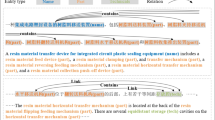Abstract
As a subtask of information extraction (IE), which aims to extract structured information from texts, event extraction is to recognize event trigger mentions of a predefined event type and their arguments. In general, event extraction can be divided into two subtasks: trigger extraction and argument extraction. Currently, the frequent existences of unannotated trigger mentions and poor-context trigger mentions impose critical challenges in Chinese trigger extraction. This paper proposes a novel three-layer joint model to integrate three components in trigger extraction, i.e., trigger identification, event type determination, and event subtype determination. In this way, different kinds of evidence on distinct pseudo samples can be well captured to eliminate the harmful effects of those un-annotated trigger mentions. In addition, this paper introduces various types of linguistically driven constraints on the trigger and argument semantics into the joint model to recover those poor-context trigger mentions. The experimental results show that our joint model significantly outperforms the state-of-the-art Chinese trigger extraction and Chinese event extraction as a whole.
Similar content being viewed by others
References
Ji H, Grishman R. Refining event extraction through crossdocument inference. In Proc. the 46th ACL, Jun. 2008, pp.254-262.
Liao S, Grishman R. Using document level cross-event inference to improve event extraction. In Proc. the 48th ACL, Jul. 2010, pp.789-797.
Huang R, Riloff E. Modeling textual cohesion for event extraction. In Proc. the 26th AAAI, Jul. 2012, pp.1664-1770.
Lu W, Roth D. Automatic event extraction with structured preference modelling. In Proc. the 50th ACL, Jul. 2012, pp.835-844.
Li Q, Ji H, Huang L. Joint event extraction via structured prediction with global features. In Proc. the 51st ACL, Aug. 2013, pp.73-82
Chen Z, Ji H. Language specific issue and feature exploration in Chinese event extraction. In Proc. HLT NAACL, May 31-June 5, 2009, pp.209-212.
Li P, Zhou G, Zhu Q, Hou L. Employing compositional semantics and discourse consistency in Chinese event extraction. In Proc. EMNLP-CoNLL, Jul. 2012, pp.1006-1016.
Chen C, Ng V. Joint modeling of Chinese event extraction with rich linguistic features. In Proc. the 24th COLING, Dec. 2012, pp.529-544.
Hong Y, Zhang J, Ma B, Yao J, Zhou G, Zhu Q. Using cross-entity inference to improve event extraction. In Proc. the 49th HLT, Jun. 2011, pp.1127-1136.
Li P, Zhu Q, Diao H, Zhou G. Joint modeling of trigger identification and event type determination in Chinese event extraction. In Proc. COLING, Dec. 2012, pp.1635-1652.
Ahn D. The stages of event extraction. In Proc. COLING/ACL Workshop on Annotating and Reasoning about Time and Events, Jul. 2006.
Li X, Nguyen T, Cao K, Grishman R. Improving event detection with abstract meaning representation. In Proc. the 1st Workshop on Computing News Storylines, Jul. 2015, pp.11-15.
Patwardhan S, Riloff E. A unified model of phrasal and sentential evidence for information extraction. In Proc. EMNLP, Aug. 2009, pp.151-160.
Nguyen T, Grishman R. Event detection and domain adaptation with convolutional neural networks. In Proc. the 53rd ACL, Jul. 2015, pp.365-371.
Chen Y, Xu L, Liu K, Zeng D, Zhao J. Event extraction via dynamic multi-pooling convolutional neural networks. In Proc. the 53rd ACL, Jul. 2015, pp.167-176.
Li P, Zhou G. Employing morphological structures and sememes for Chinese event extraction. In Proc. the 24th COLING, Dec. 2012, pp.1619-1634.
Chen Z, Ji H. Can one language bootstrap the other: A case study on event extraction. In Proc. NAACL/HLT Workshop on Semi-Supervised Learning for Natural Language Processing, Jun. 2009, pp.66-74.
Qin B, Zhao Y, Ding X, Liu T, Zhai G. Event type recognition based on trigger expansion. Tsinghua Science and Technology, 2010, 15(3): 251-258.
Mei J, Zhu Y, Gao Y, Yin X. TongYiCiCiLin. Shanghai: Shanghai Lexicographical Publishing House, 1996. (In Chinese)
Li P, Zhu Q, Zhou G. Using compositional semantics and discourse consistency to improve Chinese trigger identification. Information Processing and Management, 2014, 50(2): 399-415.
Zeng X, Wong D, Chao L, Trancoso I. Graph-based semisupervised model for joint Chinese word segmentation and Part-of-Speech tagging. In Proc. the 51st ACL, Aug. 2013, pp.770-779.
Qian X, Liu Y. Joint Chinese word segmentation, POS tagging and parsing. In Proc. EMNLP, Jul. 2012, pp.501-511.
Li Z, Zhang M, Che W, Liu T. A separately passiveaggressive training algorithm for joint POS tagging and dependency parsing. In Proc. the 24th COLING, Dec. 2012, pp.1681-1698.
Li J, Zhou G, Ng H. Joint syntactic and semantic parsing of Chinese. In Proc. the 48th ACL, Jul. 2010, pp.1108-1117.
Riedel S, Chun H, Takagi T, Tsujii J. A Markov logic approach to bio-molecular event extraction. In Proc. BioNLP, June 2009, pp.41-49.
Poon H, Vanderwende L. Joint inference for knowledge extraction from biomedical literature. In Proc. HLT-NAACL, Jun. 2010, pp.813-821.
Riedel S, McCallum A. Fast and robust joint models for biomedical event extraction. In Proc. EMNLP, Jul. 2011, pp.1-12.
Araki J, Mitamura T. Joint event trigger identification and event coreference resolution with structured perceptron. In Proc. EMNLP, Sept. 2015, pp.2074-2080.
Li P, Zhu Q, Zhou G. Joint modeling of argument identification and role determination in Chinese event extraction with discourse-level information. In Proc. the 23rd IJCAI, Aug. 2013, pp.2120-2126.
Xue N. Labeling Chinese predicates with semantic roles. Computational Linguistics, 2008, 34(2): 225-255.
Roth D, Yih W. A linear programming formulation for global inference in natural language tasks. In Proc. CoNLL, May 2004, pp.1-8.
Li P, Zhu Q, Zhou G. Argument inference from relevant event mentions in Chinese argument extraction. In Proc. the 51st ACL, Aug. 2013, pp.1477-1487.
Author information
Authors and Affiliations
Corresponding author
Electronic supplementary material
Below is the link to the electronic supplementary material.
ESM 1
(PDF 95 kb)
Rights and permissions
About this article
Cite this article
Li, PF., Zhou, GD. Three-Layer Joint Modeling of Chinese Trigger Extraction with Constraints on Trigger and Argument Semantics. J. Comput. Sci. Technol. 32, 1044–1056 (2017). https://doi.org/10.1007/s11390-017-1780-5
Received:
Revised:
Published:
Issue Date:
DOI: https://doi.org/10.1007/s11390-017-1780-5




